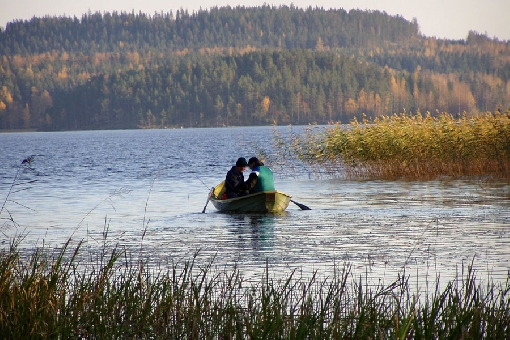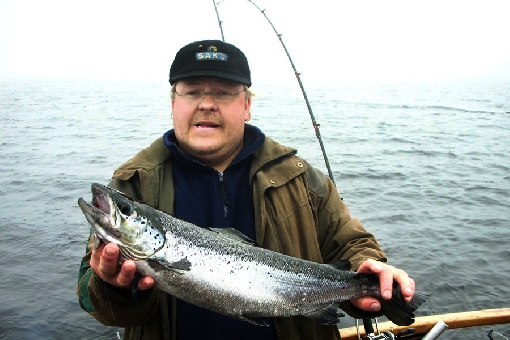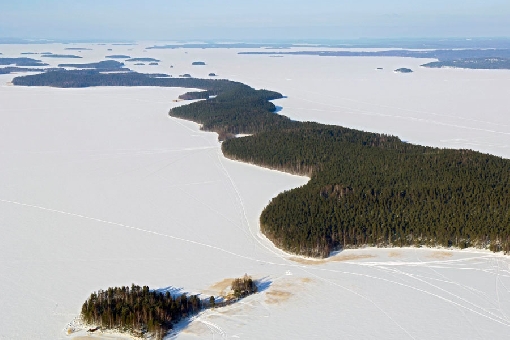Lake Päijänne - good enough to drink
Photo: Veli-Matti Paananen The Kirkkoselkä mid-lake area in Korpilahti in the northern part of Lake Päijänne.
The mighty Lake Päijänne is located in Southern Finland, extending from the City of Lahti to the City of Jyväskylä. This limpid lake is one of the most popular recreational fishing sites in Finland. This is no wonder, as its pure water, wide open mid-lake areas and well-stocked fishing grounds provide anglers with challenges, catches and plenty of delightful sights.Despite its popularity, there is plenty of space on this large lake. Lake Päijänne is the deepest and second largest lake in Finland. Its landscapes are characterised by bareness and majestic scenery, with islands and shores rising steeply from the depths of the lake. Pike from bays The most common game species on Lake Päijänne include pike and perch. Shallow reedy bays and rushes and shoals between islands make for good spots for catching pike. There are plenty of potential pike areas along the western shores of Lake Päijänne, in the bay waters off Jämsä, Kuhmoinen and Padasjoki. Good pike spots on the eastern shores include the lush narrow passages near Sysmä and Luhanka. To the North, there are plenty of great bay waters for anglers in pursuit of pike off the City of Jyväskylä. You can also catch big pike amidst schools of vendace on the wide open mid-lake areas of Lake Päijänne. The zander stock has become stronger on Lake Päijänne and anglers can now catch specimens weighing several kilos. Zander and pike stocks are strongest in the northern part of the lake, where waters are slightly more lush and darker. Mid-lake shallows and sounds between islands are the location of choice for anglers going after zander. Photo: Veli-Matti Paananen  Big pike swim around in Sammallahti Bay, Jämsä. Trout from mid-lake areas In spring and autumn, trollers aim to hook brown trout and landlocked salmon on the end of their lines. The wide open mid-lake areas and deep waters create a splendid setting for trolling. Brown trout are stocked in large numbers and the water routes flowing into the lake have been restored so as to ensure natural reproduction. Anglers in pursuit of salmonoids head to the deeps of the extensive open areas of the central part of Lake Päijänne, Tehinselkä and Judinsalonselkä, and the edges of these. In the southern part, excellent trolling sites can be found on both sides of Pulkkilanharju Ridge that splits the lake in two. Photo: Veli-Matti Paananen  This landlocked salmon struck a baitfish rig trolled just below the surface in the Judinsalonselkä mid-lake area of Lake Päijänne in late May. In summer, hook-and-line anglers find bream, roach and ide in reedy bays. The southern part of Lake Päijänne is a significant site for catching signal crayfish. In winter, Lake Päijänne is a popular ice-fishing site. The deep water body makes for a challenging ice-fishing lake. Anglers ice-fishing burbot head to the mouths and bottoms of spawning bays where waters are a couple of metres deep. Photo: Lentokuva Vallas  Kelvenne Island in Lake Päijänne National Park. Sandy ridges and rocky islands in national parks The southern parts of the lake are home to Päijänne National Park with plenty of campfire sites, lean-tos, camp sites for tents and hiking trails. The key island within the National Park is the serpentine Kelvenne on the Virmailanselkä mid-lake area. Lake Päijänne offers diverse sceneries. Islands located next to each other may vary from steep and majestic mounds of rock to smooth and even beaches. The National Park's landscape is animated by ridge sceneries. Many islands have kettle bays, i.e. ridge hollows filled with water, which make for excellent natural harbours for boaters and anglers. The quality of water in the northern part of the lake is good, while the southern part has clear and excellent water. The Helsinki Metropolitan Area takes its drinking water from Lake Päijänne. |